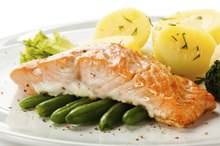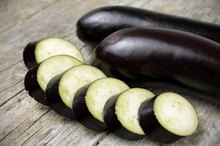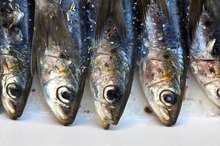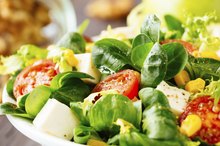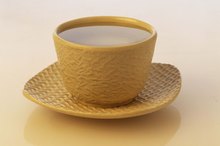Tuna & Gout
One of medicine's oldest known diseases, gout is a type of arthritis characterized by sudden, intense pain in the joints caused by the buildup of uric acid crystals. When the body breaks down chemicals called purines, found in some foods, it creates uric acid; when too much uric acid collects in your system, it forms crystals and causes painful inflammation. Reducing high-purine foods -- such as tuna -- in your diet can decrease your body's production of uric acid and the chance that gout will develop or reoccur.
Tuna and Purines
Gout sufferers should reduce or eliminate their intake of seafood that is very high in purines, including lobster, shrimp, anchovies, sardines, mackerel, scallops and mussels. In comparison, tuna is moderately high in purine. According to the Gout & Uric Acid Education Society, a 2004 study published in the "New England Journal of Medicine" found that each additional weekly serving of seafood led to a 7 percent increase in the risk of developing gout in middle-aged men.
Recommended Servings
Atlantic Salmon & Gout
Learn More
The Scarsdale Medical Group website recommends reducing your intake of meat, fish or poultry, including tuna, to 4 to 6 oz. per day to ward off gout symptoms. The USDA's "Dietary Guidelines for Americans, 2010" reports that the average American consumes about 3.5 ounces of seafood per week and recommends increased consumption. For an adult consuming a diet of 2,000 calories a day, the DASH -- Dietary Approaches to Stop Hypertension -- eating plan suggests a maximum of 6 ounces of lean protein, including seafood, per day.
- The Scarsdale Medical Group website recommends reducing your intake of meat, fish or poultry, including tuna, to 4 to 6 oz.
- For an adult consuming a diet of 2,000 calories a day, the DASH -- Dietary Approaches to Stop Hypertension -- eating plan suggests a maximum of 6 ounces of lean protein, including seafood, per day.
Dietary Benefits
Tuna offers dietary benefits aside from its moderate purine level. It's a major source of omega-3 fatty acids, a type of polyunsaturated fat that encourages coronary health. The omega-3s found in tuna may also reduce the risk of diabetes, stroke, asthma, ulcerative colitis, some cancers and other conditions. This cold-water fish, whether eaten canned or freshly cooked, is a lean protein with much less cholesterol and saturated fat than in red meat.
- Tuna offers dietary benefits aside from its moderate purine level.
- This cold-water fish, whether eaten canned or freshly cooked, is a lean protein with much less cholesterol and saturated fat than in red meat.
Dietary Concerns
Fish That Are High in Purines
Learn More
While tuna presents numerous health benefits for gout sufferers, some species are also high in mercury and PCBs. The Monterey Bay Aquarium's Seafood Watch program recommends avoiding Bluefin and some other species because of elevated mercury levels. American-caught Albacore and Skipjack, the most commonly canned species, are the safest. But canned tuna also contains high levels of sodium. Though salt is low in purines, people with gout should choose lower-salt varieties to maintain optimum overall health.
- While tuna presents numerous health benefits for gout sufferers, some species are also high in mercury and PCBs.
- The Monterey Bay Aquarium's Seafood Watch program recommends avoiding Bluefin and some other species because of elevated mercury levels.
Related Articles
References
- Gout and Uric Acid Education Society: Gout Diet
- National Institute of Arthritis and Musculoskeletal and Skin Diseases. Gout. Updated April 2016.
- Zhang Y, Chen C, Choi H, et al. Purine-rich foods intake and recurrent gout attacks. Ann Rheum Dis. 2012; 71(9):1448-53. doi:10.1136/annrheumdis-2011-201215
- Fischer E. Ueber die Harnsauer. 1 [On Uric Acid. 1]. Berichte der Deutschen Chemischen Gesellschaft. 1884: 17:328-338. doi:10.1002/cber.18980310304
- Ragab, G., Elshahaly, M., & Bardin, T. (2017). Gout: An old disease in new perspective – A review. Journal of Advanced Research, 8(5), 495–511. doi:10.1016/j.jare.2017.04.008
- Centers for Disease Control and Prevention. Gout. Updated January 28, 2019.
- Zgaga, L., Theodoratou, E., Kyle, J., Farrington, S. M., Agakov, F., Tenesa, A., … Campbell, H. (2012). The Association of Dietary Intake of Purine-Rich Vegetables, Sugar-Sweetened Beverages and Dairy with Plasma Urate, in a Cross-Sectional Study. PLoS ONE, 7(6), e38123. doi:10.1371/journal.pone.0038123
- Choi HK, Gao X, Curhan G. Vitamin C intake and the risk of gout in men: a prospective study. Arch Intern Med. 2009;169(5):502–507. doi:10.1001/archinternmed.2008.606
- Zhang Y, Neogi T, Chen C, Chaisson C, Hunter DJ, Choi HK. Cherry consumption and decreased risk of recurrent gout attacks. Arthritis Rheum. 2012;64(12):4004–4011. doi:10.1002/art.34677
- Arthritis Foundation. Gout Diet: Dos and Don’ts.
- Boban M, Modun D. Uric acid and antioxidant effects of wine. Croat Med J. 2010;51(1):16–22. doi:10.3325/cmj.2010.51.16
- Caliceti C, Calabria D, Roda A, Cicero AFG. Fructose Intake, Serum Uric Acid, and Cardiometabolic Disorders: A Critical Review. Nutrients. 2017;9(4):395. Published 2017 Apr 18. doi:10.3390/nu9040395
- U.S. Department of Health and Human Services and U.S. Department of Agriculture. 2015–2020 Dietary Guidelines for Americans. 8th Edition. Published December 2015.
- U.S. Department of Health and Human Services. Gripped by Gout. NIH News in Health. Published February 2014.
- Kakutani-Hatayama M, Kadoya M, Okazaki H, et al. Nonpharmacological Management of Gout and Hyperuricemia: Hints for Better Lifestyle. Am J Lifestyle Med. 2015;11(4):321–329. Published 2015 Sep 2. doi:10.1177/1559827615601973
